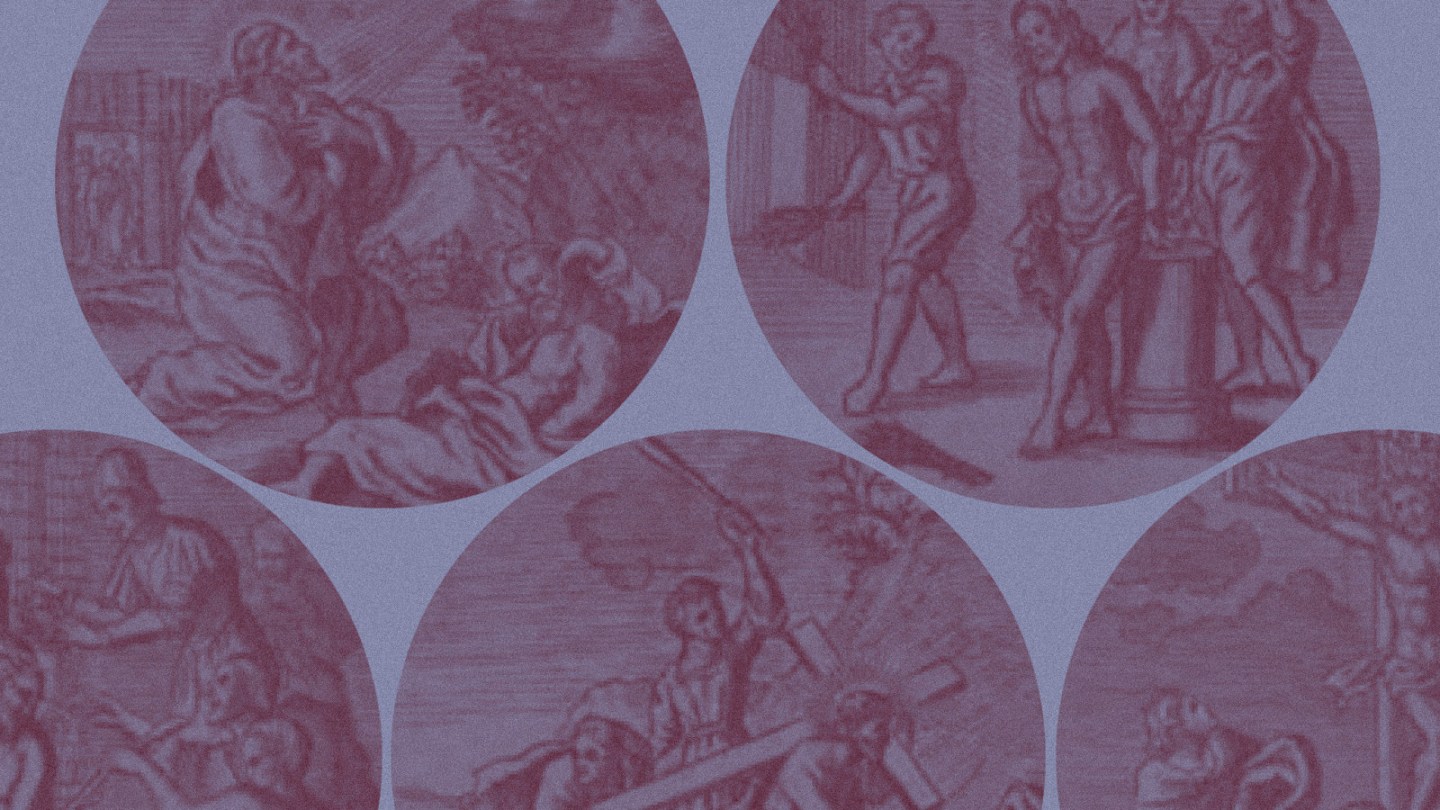“If Marina Abramovic had been a violinist, she would’ve been drawn to” Heinrich Ignaz Franz von Biber’s “Rosary” or “Mystery” Sonatas for violin and continuo, violinist Daniel Pioro tells me. With organist James McVinnie, Pioro performs the complete “Rosary” Sonatas at London’s Southbank Centre on January 22. The cycle is spread across three performances in one day: The first is at 8 a.m., in the foyer of the Queen Elizabeth Hall, as dawn breaks over London; the second at noon, in the cloistered darkness of the Purcell Room, shutting out natural light for the torture and execution of Christ. The Resurrection sees the audience return to the foyer at 4 p.m. Dusk will begin to fall, but hope of the world is renewed. This Lent, become a Be-liBer.
Completed and compiled around 1675, the “Rosary” Sonatas comprise 15 suites of movements—often dances—and a concluding Passacaglia for solo violin. The piece is divided into three: five “Joyful Mysteries” (Christ’s nativity and childhood), five “Sorrowful Mysteries” (the Passion), and five “Glorious Mysteries” (resurrection and ascension).
Biber’s violin writing is less florid than his Italian contemporaries—think Vivaldi or Geminiani—and more chordal and contrapuntal: denser, heavier, more freighted with northern European gloom and metaphysical intensity. His music uses the binary and variation forms of Baroque suites to pose questions and tease out their answers. It is technically demanding but inward-looking rather than outwardly virtuosic, giving the impression of something being worked over. It is rigorous but not joyless: the sonatas are animated by lively dances, just as in Bach’s Passions. The emotional and sonic range of Biber’s journey comes from its use of scordatura: the violin is continually re-tuned across the cycle into extraordinary new harmonic configurations.
For Pioro, this performance of the “Rosary” Sonatas is a “call to prayer,” a devotion evident in his decision to be ready to perform at 8 a.m. on a Sunday. “I want people to be there with blankets around their shoulders, huddled there,” he says. “People will have traveled there by train, stayed up during the night, and stayed with a friend… It is a pilgrimage for all of us.”
The “Rosary” Sonatas got their title from the engraved miniatures in the manuscript depicting episodes from the life of Christ, from birth to ascension. They may have adjoined Rosary processions, rituals of reflection and meditation on the same episodes accompanied by prayer and readings.
The religious and spiritual resonance of performing the “Rosary” Sonatas on a Sunday is not lost on Pioro. He, organist McVinnie, stage managers, and ushers will be keeping monastic hours in order to rise for the performance. Audiences must make a special effort to catch the start of the cycle, as the first rays of winter sunlight are scattered on the Thames. (A transcendental effect, like when the shutters open at Panorama Bar at Berlin’s Berghain, revealing the dawn as the sun rises and techno plays, or so I’m told.) Three hours of music across one day doesn’t sound like much. But the sustained immersion in one musical world, and the relative economy of means—violin, organ, and harpsichord—demand dedication from audience and performers alike.
These are ideal conditions for a heightened experience of musical meditation. It’s the kind of deep listening we associate with avant-garde works of unusual length and endurance: Satie’s “Vexations,” Philip Glass’s “Einstein on the Beach,” or, in extremis, John Cage’s “Organ2/ASLSP (As Slow as Possible),” whose ongoing performance is scheduled to end in over 600 years.

Little is known about the original performance context of Biber’s sonatas. Did they accompany acts of devotion? On what kind of scale was this intimate music felt and thought? Pioro’s performance, whose circumstances hand audiences an unusually polished contemplative lens, evokes a very particular meditative tradition.
Biber’s “Rosary” cycle reflects a way of focusing the mind derived from the composer’s Jesuit upbringing. St. Ignatius of Loyola was the intellectual powerhouse behind the Jesuit tradition in the late Renaissance. His “Spiritual Exercises” provide a rigorous physical and mental framework of contemplation, in which every narrative, idea, and prayerful word is caressed through examination. One section imagines intoning the Pater Noster by taking a new breath for each word, turning over the text and its attendant meanings with infinite, rhythmic patience. Musical parallels are not hard to draw in the variation forms of chaconne and passacaglia employed by Biber in his sonatas.
According to Roland Barthes, St. Ignatius’s “Spiritual Exercises” are “‘scenes’ the exercitant is called upon to live out, as in a psychodrama.” There are three stops on the exercitant’s mental journey. In the first, they contemplate a scene and recall its narrative. In the second, they imagine its composition in minute detail: the hair, the clothes, the perfume of the air, the sounds of the environment. The third turns back on the self—the exercitant asks what they want and how they grasp the meaning of the scene. “The exercitant is in fact called upon to invest himself in the narrative… He is to repeat what depresses, consoles, traumatizes, enraptures him in each narrative; he is to live the anecdote by identifying himself with Christ,” writes Barthes.
Biber reconciles Ignatian meditation with his musical formulae. The music is at times vividly pictorial: “You can hear the cross dragging along the floor,” Pioro says of the ninth sonata. In “The Crucifixion,” dotted triplets suggest the faltering gasps of a man trying to catch his breath. But it is the mental schemata that are most deeply embedded in his musical logic. Repetition is one of the cornerstones of Ignatius’ exercises, and this methodical working over of an idea is reflected in the Baroque era’s customary repetitions of eight or twelve bar sequences, which reappear with embellishment. Many of the sonatas in the sequence have a tripartite shape—Sonata, Allemande, Finale—which reproduces the mental movement through narrative, composition, and reflection described in Ignatian devotion.
The latest from VAN, delivered straight to your inbox
Scordatura is a technique for stringed instruments that denatures their sound. The normal tunings of violin, viola, and cello are built from open fifths: to deviate from this path is the acoustical equivalent of stepping into a painting by Salvador Dalí. Raising or lowering individual strings dampens and brightens their sound, and changes their relationships to each other. The bass in Biber’s chordal writing often has obtrusive heft; higher tones have a pall draped over them. The acoustic properties of a violin undergo a disturbing yet oddly miraculous transformation when tuned in the various configurations Biber uses in the “Rosary” Sonatas. It’s the sound of a melting clock.
The pressure on the instrument increases as the sonatas go on; the effects are carefully tailored to the scenes. The first, “The Annunciation,” begins as normal. In the sixth, “The Agony in the Garden,” the violin is tuned with two clashing pairs of fifths: A-flat and E-flat; G and D. The lowering of the top two strings draws a veil over the sound; raising the tension of the bottom two increases the feeling of claustrophobia, squeezing the violin into a cramped acoustic space. The unreconciled pairs evoke the schism between Christ’s humanity and his destiny, as well as the loneliness he experiences in his anguish, belonging neither to the world of the human nor the divine.
In the eleventh sonata, “Resurrection,” the violin is restrung so that the usual ascending order is inverted twice, with the strings crossing in the peg box and behind the bridge. The spiritual and material transfiguration of the instrument is complete. The violin is now tuned to G major. A pedal G is held in the continuo for seventeen bars, before pivoting to a cadential D: Truly, this was the son of G-D.
Biber’s sonatas represent an elaboration of the violin’s craft so specialized that it pushes the instrument to its limits. The scordatura tuning allows for chords and multi-part dialogues impossible on a conventionally-tuned violin, as well as darker or brighter resonances and overtones, especially gnarly in non-tempered tunings, that would be otherwise inaccessible. His concluding unaccompanied Passacaglia may well have been the first of its kind, although supplanted by Bach’s more famous Chaconne.
How do you practice a piece that puts the violin under so much strain? This is not like polishing passagework for the Tchaikovsky concerto; the instrument, like a human body, simply couldn’t take the strain. Pioro’s preparation has been mostly mental, realizing the piece in his head rather than out loud. He rehearses the fingerings but plays the notated music with the standard tuning, so the sound is at one bizarre remove from the finished article. “In a few days I’ll put soft strings on my violin,” he tells me in a text. Pioro has perfect pitch, so practicing the piece at the “wrong” pitches induces a kind of musical vertigo. He has to approach the piece gently. Only in performance will the strange alchemy of Biber’s scordatura come to light.

These retunings show the scale of Biber’s technical mastery. But they can take us deep into the guts of the instrument too. Often, the violinist performing the piece will use five or six different violins, re-tuned and prepared by an assistant as the performance goes on. Daniel Pioro prefers to realize the piece on one instrument alone, re-tuned and re-strung in front of the audience. When he performed the sonatas at the Norwich & Norfolk Festival last year, this process was the basis of wholesale improvisational sequences, acoustical connective tissues that bind like sinews the bone structure and musculature of the 15 sonatas. “It’s such a special thing to see the violin so altered, taken apart, put back together,” says Pioro. “It’s possible it will be the first and last time we do it. Particularly if it’s profound and mind-altering.”
Craft means getting your hands dirty; this approach to the piece peels back the skin of the violin’s sound and shows us the rough, unformed matter from which the instrument is made. It is an approach reflected on Pioro’s new disc “Saint Boy,” which includes “The Agony in the Garden.” The microphone is placed so close to the violin that it sounds like you are actually inside it: You can hear the breathy, hairy rustle of bow on string and the strange squeaks and groans that creep out up close. An instrument of wood, hair, gut, and glue. In Pioro’s hands, you can smell the farmyard.
Scordatura warps musical perception because it sunders the relationship between the visible and audible in an alchemical way. This is more than just transposition, where the pitches change but the relationships between them stay the same. In Biber’s “Rosary” Sonatas, the violin part is written as the performer would play it on a normally-strung instrument. What you see isn’t what you get.
What looks dissonant sounds consonant; a descending passage can reach deeper than the eye says it should or bottom out unexpectedly early. The musical sigla of the cross is deeply embedded into Biber’s 15 sonatas. The magic of a re-tuned violin means that at times aural presence is magnified beyond its place on the page. The shape of the cross suddenly looms. This is indivisible from the spiritual significance of the piece. The mystery that binds the 15 sonatas exists in the disturbance of seen and heard. The Resurrection story is one of stupefaction and incredulity: a body broken, killed, now alive again. Like Thomas seeing the risen Christ, we simply cannot take it in. What looks like death is in fact the triumph of life; what looks harsh on the page is sweet to the ear; what looks like musical disturbance is in fact reconciliation. These theological mysteries, which live through the senses even as they defy them, pass through the violin’s hallowed body. ¶
Subscribers keep VAN running!
VAN is proud to be an independent classical music magazine thanks to our subscribers. For just over 10 cents a day, you can enjoy unlimited access to over 875 articles in our archives—and get new ones delivered straight to your inbox each week.
Not ready to commit to a full year?
You can test-drive VAN for one month for the price of a coffee.


